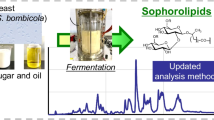Abstract
Biosurfactant production of eight Streptococcus thermophilus strains, isolated from heat exchanger plates in the downstream side of the regenerator section of pasteurizers in the dairy industry has been measured using axisymmetric drop shape analysis by profile (ADSA-P). Strains were grown in M17 broth with either lactose, saccharose or glucose added. After harvesting, cells were suspended in water or in 10 mm potassium phosphate buffer, pH 7.0, and suspension droplets were put on a piece of FEP-Teflon. Changes in droplet profile were analysed by ADSA-P to yield the surface tension decrease due to biosurfactant production as a function of time. Surface tension decreases larger than 8 mJ·m−2 were taken as indicative of biosurfactant production. Only five strains produced biosurfactants in water, solely when saccharose was added to the growth medium. In buffer, all strains produced biosurfactants and production was generally greater than in water. Also, most strains suspended in buffer produced maximally when saccharose was added to the growth medium, whereas one strain produced maximally in buffer upon the addition of glucose. Four strains suspended in buffer produced biosurfactants when glucose was added and only two strains when lactose was added. The possible role of these biosurfactants as anti-adhesives in the dairy industry and for the survival of these strains in natural systems is discussed.
Similar content being viewed by others
References
Aveyard R, Haydon DA (1973) An introduction to the principles of surface chemistry. Cambridge University Press, London
Bouwman S, Lund D, Driessen FM, Schmidt DG (1982) Growth of thermoresistant streptococci and deposition of milk constituents on plates of heat exchangers during long operating times. J Food Prot 45:806–812
Busscher HJ, Bellon-Fontaine MN, Mozes N, Mei HC van der, Sjollema J, Cerf O, Rouxhet PG (1990) Deposition of Leuconostoc mesenteroides and Streptococcus thermophilus to solid substrata in a parallel plate flow cell. Biofouling 2:55–63
Cabacungan E, Pieringer RA (1980) Excretion of extracellular lipids by Streptococcus mutans BHT and FA-1. Infect Immun 27:556–562
Haferburg D, Hommel R, Claus R, kleber HP (1986) Extracellular microbial lipids as biosurfactants. Adv Biochem Eng Biotechnol 33:53–93
Jenkinson HF (1992) Adherence, coaggregation, and hydrophobicity of Streptococcus gordonii associated with expression of cell surface lipoproteins. Infect Immun 60:1225–1228
Kurita T, Hirasawa M (1988) Biological and biochemical characterization of novel lipid-like antibacterial substances (mutalipocins) produced by Streptococcus mutants strain 32K. J Gen Microbiol 134:213–220
Mozes N, Marchal F, Hermesse M, Haecht JL van, Reuliaux L, Léonard AJ, Rouxhet PG (1987) Immobilization of microorganisms by adhesion; interplay of electrostatic and non-electrostatic interactions. Biotechnol Bioeng 30:439–450
Neu TR (1992) Microbial “footprints” and the general ability of microorganisms to label interfaces. Can J Microbiol 38:1005–1008
Neu TR, Marshall KC (1990) Bacterial polymers: physicochemical aspects of their interactions at interfaces. J Biomater Appl 5:107–133
Neu TR, Marshall KC (1991) Microbial “footprints” — a new approach to adhesive polymers. Biofouling 3:101–112
Neu TR, Poralla K (1988) An amphiphilic polysaccharide from an adhesive Rhococcus strain. FEMS Microbiol Lett 49:389–392
Noordmans J, Busscher HJ (1991) The influence of droplet volume and contact angle on liquid surface tension measurements by axisymmetric drop shape analysis-profile. Coll Surf 58:239–249
Pratt-Terpstra IH, Weerkamp AH, Busscher HJ (1989) Microbial factors in a thermodynamic approach of oral streptococcal adhesion to solid substrata. J Colloid Interface Sci 129:568–574
Rosenberg E (1986) Microbial surfactants. CRC Crit Rev Biotechnol 3:109–132
Rotenberg Y, Boruvka L, Neumann AW (1983) Determination of surface tension and contact angle from the shapes of axisymmetric fluid interfaces. J Colloid Interface Sci 93:169–183
Syldatk C, Lang S, Matulovic U, Wagner F (1985) Production of four interfacial rhamnolipids from n-alkanes or glycerol by resting cells of Pseudomonas species DSM 2874. Z Naturforsch 40c:61–67
Thomas TD, Crow VL (1983) Lactose and sucrose utilization by Streptococcus thermophilus. FEMS Microbiol Lett 17:13–17
Vegt W van der, Mei HC van der, Noordmans J, Busscher HJ (1991) Assessment of bacterial biosurfactant production through axisymmetric drop shape analysis by profile. Appl Microbiol Biotechnol 35:766–770
Author information
Authors and Affiliations
Additional information
Correspondence to: H. J. Busscher
Rights and permissions
About this article
Cite this article
Busscher, H.J., Neu, T.R. & van der Mei, H.C. Biosurfactant production by thermophilic dairy streptococci. Appl Microbiol Biotechnol 41, 4–7 (1994). https://doi.org/10.1007/BF00166073
Received:
Revised:
Accepted:
Issue Date:
DOI: https://doi.org/10.1007/BF00166073




